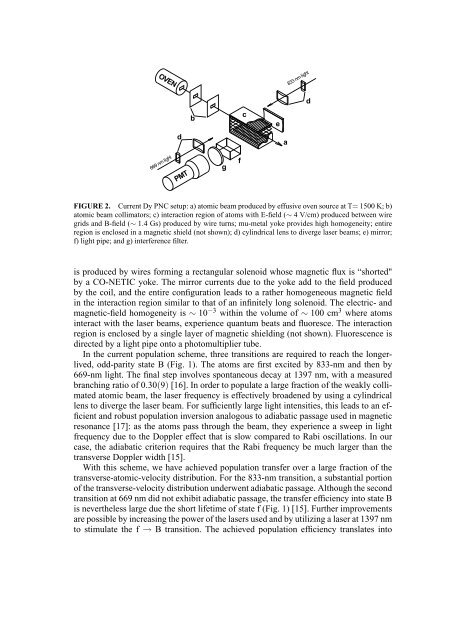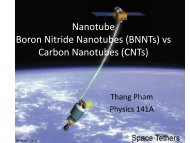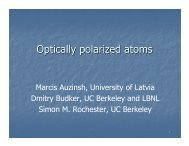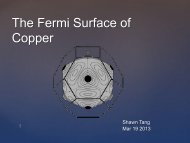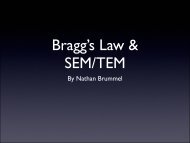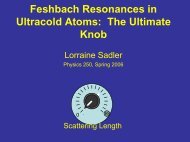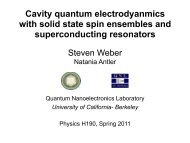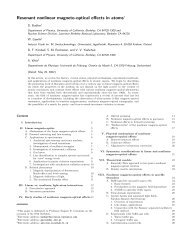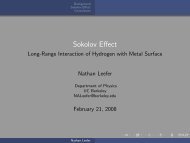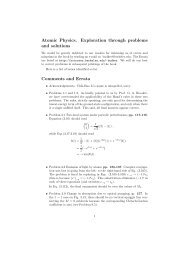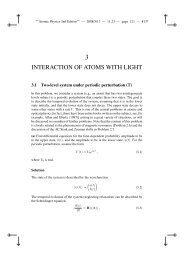Atomic Tests of Discrete Symmetries at Berkeley - The Budker Group
Atomic Tests of Discrete Symmetries at Berkeley - The Budker Group
Atomic Tests of Discrete Symmetries at Berkeley - The Budker Group
You also want an ePaper? Increase the reach of your titles
YUMPU automatically turns print PDFs into web optimized ePapers that Google loves.
FIGURE 2. Current Dy PNC setup: a) <strong>at</strong>omic beam produced by effusive oven source <strong>at</strong> T= 1500 K; b)<br />
<strong>at</strong>omic beam collim<strong>at</strong>ors; c) interaction region <strong>of</strong> <strong>at</strong>oms with E-field (∼ 4 V/cm) produced between wire<br />
grids and B-field (∼ 1.4 Gs) produced by wire turns; mu-metal yoke provides high homogeneity; entire<br />
region is enclosed in a magnetic shield (not shown); d) cylindrical lens to diverge laser beams; e) mirror;<br />
f) light pipe; and g) interference filter.<br />
is produced by wires forming a rectangular solenoid whose magnetic flux is “shorted"<br />
by a CO-NETIC yoke. <strong>The</strong> mirror currents due to the yoke add to the field produced<br />
by the coil, and the entire configur<strong>at</strong>ion leads to a r<strong>at</strong>her homogeneous magnetic field<br />
in the interaction region similar to th<strong>at</strong> <strong>of</strong> an infinitely long solenoid. <strong>The</strong> electric- and<br />
magnetic-field homogeneity is ∼ 10 −3 within the volume <strong>of</strong> ∼ 100 cm 3 where <strong>at</strong>oms<br />
interact with the laser beams, experience quantum be<strong>at</strong>s and fluoresce. <strong>The</strong> interaction<br />
region is enclosed by a single layer <strong>of</strong> magnetic shielding (not shown). Fluorescence is<br />
directed by a light pipe onto a photomultiplier tube.<br />
In the current popul<strong>at</strong>ion scheme, three transitions are required to reach the longerlived,<br />
odd-parity st<strong>at</strong>e B (Fig. 1). <strong>The</strong> <strong>at</strong>oms are first excited by 833-nm and then by<br />
669-nm light. <strong>The</strong> final step involves spontaneous decay <strong>at</strong> 1397 nm, with a measured<br />
branching r<strong>at</strong>io <strong>of</strong> 0.30(9) [16]. In order to popul<strong>at</strong>e a large fraction <strong>of</strong> the weakly collim<strong>at</strong>ed<br />
<strong>at</strong>omic beam, the laser frequency is effectively broadened by using a cylindrical<br />
lens to diverge the laser beam. For sufficiently large light intensities, this leads to an efficient<br />
and robust popul<strong>at</strong>ion inversion analogous to adiab<strong>at</strong>ic passage used in magnetic<br />
resonance [17]: as the <strong>at</strong>oms pass through the beam, they experience a sweep in light<br />
frequency due to the Doppler effect th<strong>at</strong> is slow compared to Rabi oscill<strong>at</strong>ions. In our<br />
case, the adiab<strong>at</strong>ic criterion requires th<strong>at</strong> the Rabi frequency be much larger than the<br />
transverse Doppler width [15].<br />
With this scheme, we have achieved popul<strong>at</strong>ion transfer over a large fraction <strong>of</strong> the<br />
transverse-<strong>at</strong>omic-velocity distribution. For the 833-nm transition, a substantial portion<br />
<strong>of</strong> the transverse-velocity distribution underwent adiab<strong>at</strong>ic passage. Although the second<br />
transition <strong>at</strong> 669 nm did not exhibit adiab<strong>at</strong>ic passage, the transfer efficiency into st<strong>at</strong>e B<br />
is nevertheless large due the short lifetime <strong>of</strong> st<strong>at</strong>e f (Fig. 1) [15]. Further improvements<br />
are possible by increasing the power <strong>of</strong> the lasers used and by utilizing a laser <strong>at</strong> 1397 nm<br />
to stimul<strong>at</strong>e the f → B transition. <strong>The</strong> achieved popul<strong>at</strong>ion efficiency transl<strong>at</strong>es into


